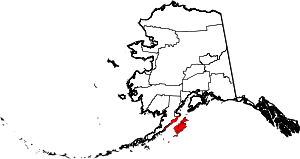Old Harbor, Alaska
| Old Harbor Nuniaq | |
|---|---|
| City | |
 Aerial view of Old Harbor | |
 Old Harbor Location in Alaska | |
| Coordinates: 57°11′50″N 153°18′28″W / 57.19722°N 153.30778°WCoordinates: 57°11′50″N 153°18′28″W / 57.19722°N 153.30778°W | |
| Country | United States |
| State | Alaska |
| Borough | Kodiak Island |
| Incorporated | June 3, 1966[1] |
| Government | |
| • Mayor | Rick Berns[2] |
| • State senator | Gary Stevens (R) |
| • State rep. | Louise Stutes (R) |
| Area[3] | |
| • Total | 26.52 sq mi (68.69 km2) |
| • Land | 20.53 sq mi (53.17 km2) |
| • Water | 5.99 sq mi (15.52 km2) |
| Elevation | 3 ft (1 m) |
| Population (2010) | |
| • Total | 218 |
| • Estimate (2016)[4] | 218 |
| • Density | 8.22/sq mi (3.17/km2) |
| Time zone | UTC-9 (Alaska (AKST)) |
| • Summer (DST) | UTC-8 (AKDT) |
| ZIP code | 99643 |
| Area code | 907 |
| FIPS code | 02-57340 |
Old Harbor (Nuniaq[5] in Alutiiq) is a city in Kodiak Island Borough, Alaska, United States. At the 2010 census the population was 218,[6] down from 237 in 2000.
Geography
According to the United States Census Bureau, the city has a total area of 26.5 square miles (68.7 km2), of which 20.5 square miles (53.2 km2) is land and 6.0 square miles (15.5 km2), or 22.59%, is water.[6]
History

The community of Old Harbor has its origins in the era of Russian conquest. On August 14, 1784, Grigory Shelikhov with 130 Russian fur traders massacred (see Awa'uq Massacre) several hundred Qik’rtarmiut Sugpiat tribe of Alutiiq men, women and children at Refuge Rock, a tiny stack island off the eastern coast of Sitkalidak Island. In Alutiiq, this sacred place is known as Awa'uq ("to become numb").[7][8]
Demographics
| Historical population | |||
|---|---|---|---|
| Census | Pop. | %± | |
| 1880 | 160 | — | |
| 1890 | 86 | −46.2% | |
| 1920 | 54 | — | |
| 1930 | 84 | 55.6% | |
| 1940 | 109 | 29.8% | |
| 1950 | 121 | 11.0% | |
| 1960 | 193 | 59.5% | |
| 1970 | 290 | 50.3% | |
| 1980 | 340 | 17.2% | |
| 1990 | 284 | −16.5% | |
| 2000 | 237 | −16.5% | |
| 2010 | 218 | −8.0% | |
| Est. 2016 | 218 | [4] | 0.0% |
| U.S. Decennial Census[9] | |||
Old Harbor first appeared on the 1880 U.S. Census as an unincorporated village with 160 residents: 155 Inuit and 5 Creole (Mixed Russian and Native).[10] It returned with 86 residents in 1890, all Native.[11] It did not return again until 1920. It formally incorporated in 1966.
As of the census[12] of 2000, there were 237 people, 79 households, and 51 families residing in the city. The population density was 11.3 people per square mile (4.4/km²). There were 111 housing units at an average density of 5.3 per square mile (2.0/km²). The racial makeup of the city was 13.08% White, 73.00% Native American, and 13.92% from two or more races.
There were 79 households out of which 44.3% had children under the age of 18 living with them, 32.9% were married couples living together, 13.9% had a female householder with no husband present, and 34.2% were non-families. 26.6% of all households were made up of individuals and 3.8% had someone living alone who was 65 years of age or older. The average household size was 3.00 and the average family size was 3.60.
In the city, the age distribution of the population shows 39.7% under the age of 18, 7.6% from 18 to 24, 29.5% from 25 to 44, 19.0% from 45 to 64, and 4.2% who were 65 years of age or older. The median age was 27 years. For every 100 females, there were 127.9 males. For every 100 females of age 18 and over, there are 142.4 males.
The median income for a household in the city was $32,500, and the median income for a family was $26,000. Males had a median income of $33,750 versus $23,750 for females. The per capita income for the city was $14,265. About 30.8% of families and 29.5% of the population were below the poverty line, including 32.5% of those under the age of eighteen and none of those sixty five or over.
Education
The Old Harbor School, a K-12 rural school, is operated by the Kodiak Island Borough School District.[13]
References
- ↑ 1996 Alaska Municipal Officials Directory. Juneau: Alaska Municipal League/Alaska Department of Community and Regional Affairs. January 1996. p. 113.
- ↑ 2015 Alaska Municipal Officials Directory. Juneau: Alaska Municipal League. 2015. p. 120.
- ↑ "2016 U.S. Gazetteer Files". United States Census Bureau. Retrieved Jun 22, 2017.
- 1 2 "Population and Housing Unit Estimates". Retrieved June 9, 2017.
- ↑ ANLC : Alaska Native Place Names
- 1 2 "Geographic Identifiers: 2010 Demographic Profile Data (DP-1): Old Harbor city, Alaska". U.S. Census Bureau, American Factfinder. Retrieved March 21, 2013.
- ↑ Ben Fitzhugh (2003), The Evolution of Complex Hunter-Gatherers: archaeological evidence from the North Pacific, Kluwer Academic/Plenum Publishers, New York, 2003
- ↑ Alutiiq Museum : Old Harbor * Nuniaq
- ↑ "Census of Population and Housing". Census.gov. Retrieved June 4, 2015.
- ↑ https://www2.census.gov/prod2/decennial/documents/1880a_v1-17.pdf
- ↑ http://www2.census.gov/prod2/decennial/documents/1890a_v8-01.pdf
- ↑ "American FactFinder". United States Census Bureau. Retrieved 2008-01-31.
- ↑ "Our Schools." Kodiak Island Borough School District. Retrieved on February 15, 2017.
External links
- Kodiak.org – Information about Old Harbor
